It is a scimitar-shaped estuary that joins the Bosphorus just at the point where that strait enters the Sea of Marmara, thus forming a peninsula the tip of which is “Old Istanbul” (ancient Byzantion and Constantinople). Its Greek and English names mean the same, but the significance of the designation “golden” is obscure, while its Turkish name Haliç simply means “estuary“. It has witnessed many tumultuous historical incidents, and its dramatic vistas have been the subject of countless works of art.
The Golden Horn is a flooded prehistoric estuary. It is 7.5 kilometers long and is 750 meters across at its widest. Its maximum depth, where it flows into the Bosphorus, is about 35 meters. It is today spanned by four bridges. Moving downstream, the first is the Haliç Bridge, literally Estuary Bridge. The former Galata Bridge was damaged by a fire in 1992; it was moved to the second position in pieces, re-assembled, and restored as the Eski Galata Bridge, literally Old Galata Bridge. The third one is the Atatürk (Unkapanı) Bridge. The current Galata Bridge was completed in 1994. A fifth bridge is currently under construction to connect the subway lines of the Istanbul Metro to the north and south of the Golden Horn.
History
The Golden Horn (Keras) forms a deep natural harbor for the peninsula it encloses together with the Sea of Marmara. The Byzantine Empire had its naval headquarters there, and walls were built along the shoreline to protect the city of Constantinople from naval attacks. At the entrance to the Horn on the northern side, a large chain was pulled across from Constantinople to the old Tower of Galata to prevent unwanted ships from entering. Known among the Byzantines as the Megàlos Pyrgos (meaning “Great Tower” in Greek), this tower was largely destroyed by the Latin Crusaders during the Fourth Crusade in 1204. In 1348 the Genoese built a new tower nearby which they called Christea Turris (Tower of Christ), now called Galata Tower.
There were three notable times when the chain across the Horn was either broken or circumvented. In the 10th century the Kievan Rus’ dragged their longships out of the Bosporus, around Galata, and relaunched them in the Horn; the Byzantines defeated them with Greek fire. In 1204, during the Fourth Crusade, Venetian ships were able to break the chain with a ram. In 1453, Ottoman Sultan Mehmed II, having failed in his attempt to break the chain with brute force, instead used the same tactic as the Rus’, towing his ships across Galata over greased logs and into the estuary.
After the conquest of Constantinople in 1453, Mehmed II resettled ethnic Greeks along the Horn in the Phanar (today’s Fener). Balat continued to be inhabited by Jews, as during the Byzantine age, though many Jews decided to leave following the takeover of the city. This area was repopulated when Bayezid II invited the Jews who were expelled from Spain to resettle in Balat. Today the Golden Horn is settled on both sides, and there are parks along each shore. The Istanbul Chamber of Commerce is also located along the shore, as are Muslim, Jewish and Christian cemeteries. The Galata Bridge connects the neighborhoods of Karaköy (the ancient Galata) and Eminönü.
Until the 1980s the Horn was polluted with industrial waste, but it has since been cleaned. Today its history and beauty make it a popular tourist attraction in Istanbul.
Leonardo’s bridge
In 1502 Leonardo da Vinci produced a drawing of a single-span 240-metre (790 ft) bridge over the Golden Horn as part of a civil engineering project for Sultan Bayezid II. Leonardo’s drawings and notes regarding this bridge are currently displayed at the Museo della Scienza e della Tecnologia in Milan, Italy.
The vision of Leonardo’s Golden Horn Bridge was resurrected in 2001, when a small footbridge based on Leonardo’s design was constructed near Ås in Norway.
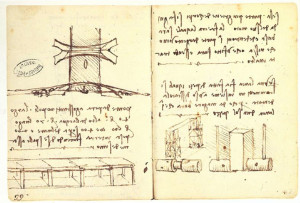
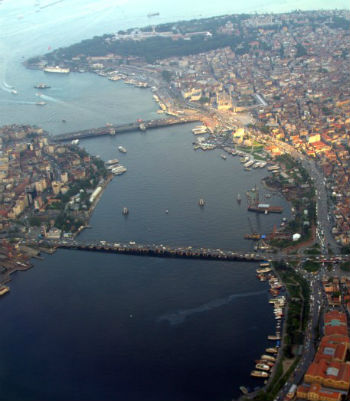
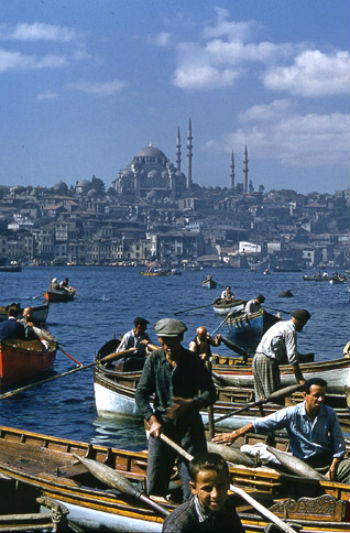
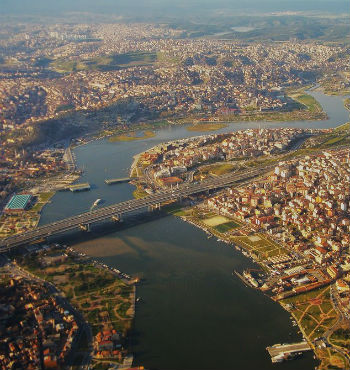
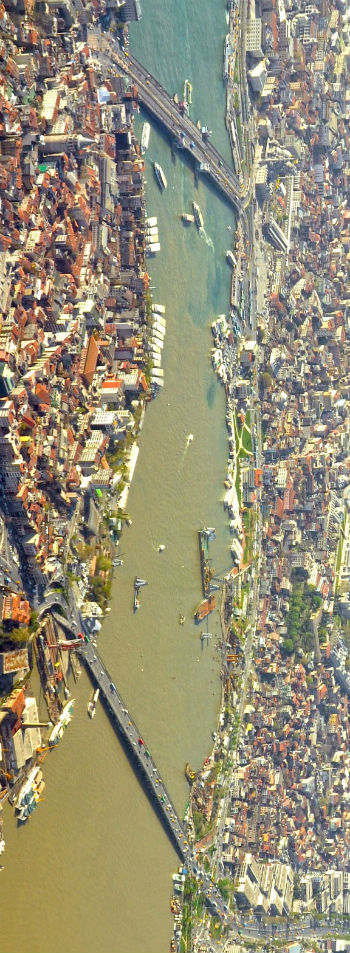


The Golden Horn is an amazing place and bigger then I expected. This area was where ships came in the past to "hide" from enemies. It is worth seeing if you are in the area. The surrounding area is a mix of old and new Istanbul, houses climb up the hill and fill the area with color.
I've been to Istanbul several times and never traveled the Golden Horn (Halic). I read about the public ferry and we boarded. It costs a rapid transit token or a swipe of the Istanbulkart each way. The ferry makes 4-5 stops, crossing from one side of the Golden Horn to the other.
The Golden Horn is a gorgeous and picturesque nature wonder: a river-like inside introduction of the Bosphorus into the continental part. There are myriads of places in the Istanbul hills to watch this beauty. In the afternoon it glows beautifully reflecting the Sun light.
it is the horn of IO in the mythology. today after cleaning works, attracts people with numerous parcs and museums surrounding.
It's good place to walk near Galata bridge to test a fish in one of the restaurants under the bridge or buy the fresh fish at the bazaar
Golden Horn separates the old and new sections of Istanbul. The commercial center of the city for 2000 years, many markets and the Chamber of Commerce still line its shores today.
See a nice view of Istanbul from the Golden Horn. The Golden Horn is a flooded pre-historic estuary.
So lovely! Its breathtaking at night when the lights off the bridge and city play against the water, and there are several really great places to eat there.
This is something to do late afternoon as the sunset and the beautiful light over the water and city is spectacular. This short trip on a ferry is not just for tourists but stops on route to drop locals off on their way home from work.
Amazing palace !